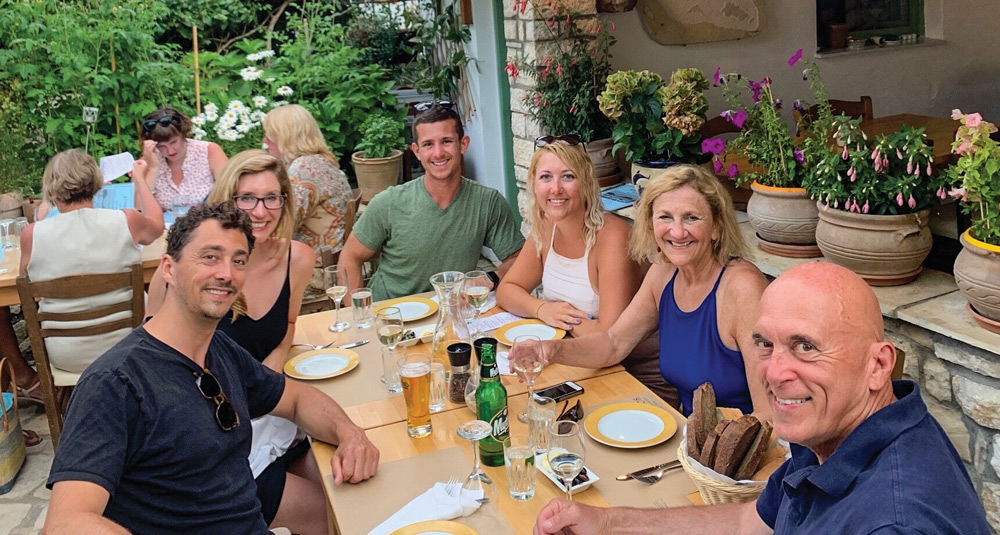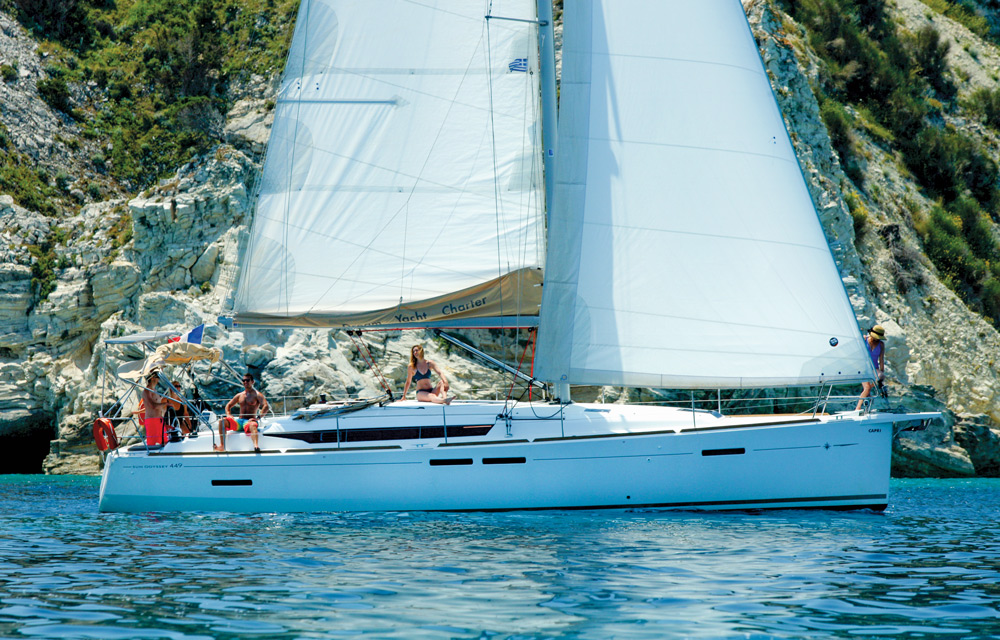Sailing Homer's Sea
A family soaks in the food, sun and perfect sailing on a charter cruise to the lesser-traveled Greek islands of the Ionian Sea
After dinner, Julie, Kelea and Nate went in search of baklava, which they easily found at the bakery, the honey and nuts encased in fresh filo dough. Lakka was so peaceful and pleasant we decided to stay another day. We spent part of the next morning exploring the sea caves outside the harbor. In Lakka we bought wine, olives, olive oil, bottled water, local salamis, cheese, bread and several bags of ice. The seawall and dinghy dock in Lakka were typical of small Greek villages, meaning sailors must make due without shore power or fresh water to refill their tanks. In such beautiful surroundings, it didn’t seem like a hardship. The ladies on board found their way to the Llios Hotel where three-minute hot showers were available for four euros.

The cruising guidebooks and articles we read prior to our travel said to expect modest fees for anchoring or mooring in the villages, but nobody ever approached us to collect in any harbor. The same sources indicated most villages lacked a dinghy dock, but offered no further information, other than to suggest mooring along a seawall near a taverna if room allowed. It left us to wonder whether we would have to swim to shore at each destination, but there was no cause for concern. Everywhere we stopped, there was room for dinghies to tie up or be hauled onto beaches. There was no expectation that you must patronize the restaurant abutting the public dock if you tied up your inflatable, though the mixed drinks and excellent service at the Fanis Bar on the water’s edge in Lakka were a welcome distraction.
No sailing adventure in the Ionian would be complete without a visit to the mainland. A glance at the chart showed the Sivota Islands and the harbor town of Mourtos were only 14 nautical miles from Paxos. The light breeze carried us to the cluster of small islands in less than three hours, requiring only one tack en route. The village of Mourtos was hidden behind islands known for their massive caves that are big enough to swallow an excursion boat and are surrounded by deep, fjord-like channels. Most boats were bow anchored with twin stern lines tied to rocks or trees on the wooded shoreline. We attempted to anchor midchannel, leaving swing room for other boats, but the depth was more than our anchor rode could handle. The hook just wouldn’t set properly with limited swing room, so we picked a spot on shore that offered two knee-high rocks suitable for tying a line around. Zack and Julie did the honors, swimming to shore with the lines and securing them. We tightened up on the anchor, let the boat settle, then piled into the dinghy for a ride to Mourtos.
Unlike Petriti and Lakka, the place had a touristy feel. We were met by a single row of open-air restaurants and cafés, and a few aggressive owners who approached with menus in hand, urging us to sit at their tables. The quay was packed with sail and powerboats and lined with vendors offering trinkets, postcards, jewelry, T-shirts and parasailing. We instinctively left the waterfront, followed a narrow alley and found a garden restaurant one block inland, where we enjoyed a meal of lamb, pasta, fish and plates laden with olives, cheeses and bread. The table was set on soft grass in the garden, encouraging us to remove our shoes during dinner and remain in touch with nature.
Our lines held fast through the night and by the time we finished our morning coffee on deck a lively wind was rippling across the channel. Casting off, we steered toward Gouvia about 22 miles northwest on Corfu and enjoyed the best sail of our trip. The sails were taut, the wind consistent, the sun relentless, which was quite a change from the cold and rainy spring New Englanders had just endured. We had a cooler filled with Fix, Alfa and Mythos beers to ward off the heat.

Our joy deflated upon entering the channel leading to the Gouvia Marina. We had to refuel the boat before returning it, but the fuel dock was a circus just as the Dream Yacht base manager had warned. When a slot finally opened, we backed in slowly, but the current pushed the boat sideways. A dockhand secured one of our stern lines and told us to abandon the second while keeping the boat gently in forward gear. We refueled as the propeller churned, keeping the line taut.
Back in our slip, the Dream Yacht crew checked out Capri, a process that included taking underwater photos of the boat’s rudder and hull to ensure no damage was done during the sail. We used the public showers adjacent to the charter company office and walked 10 minutes into downtown Gouvia for dinner. Gouvia isn’t touristy. Beer and wine are inexpensive and even the most delectable foods were reasonably priced. The wine flowed and we talked about how fast the week had gone by. Nobody wanted to leave, so we all stayed another night at a hotel in order to visit historic Corfu Town.
We had sailed past the city on our way to Petriti, the towers of Corfu Town’s old and new fortresses providing prominent landmarks. Seeing them up close from the land brought them into perspective, with their moats and defensive stone ramparts. Unlike other parts of Greece that tend to have white-washed buildings and a more Ottoman influence with domed roofs and minarets, Corfu was for many years ruled by the Italians, so its architecture has a Venetian look.
Corfu Town was enlivened by The Liston, an elegant, upscale arcade of shops and cafes designed during the brief Napoleonic occupation of Corfu in 1807. The Liston was modeled after Paris’ then new rue de Rivoli. Big churches and a warren of mazelike alleyways added to the city’s character, as did the Spianada, a sprawling green public square where locals gather. The city’s core is a UNESCO Heritage site and only pedestrians are allowed.
Most of the harbor is dominated by commercial fishing boats, private yachts, ferries and cruise ships, but visiting sailors can attempt to dock at Port Mandraki below the fortress operated by the Corfu Sailing Club. The public quay in Corfu Town is free but depths are shallow due to silting and the wake from passing traffic makes sleep difficult. Most visiting sailors grab a cab from the Gouvia Marina.
While Gouvia is an ideal place from which to explore the northern Ionian, Dream Yacht Charter has another base south of Paxos on an island connected to the mainland. The Lefkas base is closer to the islands of Ithaka, Meganissi, Skorpios and Kefalonia.
Before heading home we took a domestic flight to Santorini to see the Cyclades. The vistas were incredible, the heights dizzying and the architecture of famous whitewashed buildings with their blue domes was inspirational. We stayed at the Panorama Boutique Hotel in Fira, which is built into the cliff overlooking the caldera and the name locals have given to the hollowed out expanse of sea where a massive volcano blew its top centuries ago. Our balcony provided a sweeping view of the town, the sea, and the islands left behind by the blast. More than a 1,000 feet below cruise ships, fast-moving ferries and sailboats headed into port.
As the day waned, thousands of people gathered along the shores of Santorini to watch the sunset, among the best in the world. We happily joined them from our balcony, toasting yamas and dreaming of our next Greek sailing adventure from Lefkas or Paros.

Comments